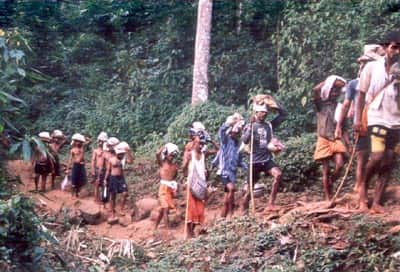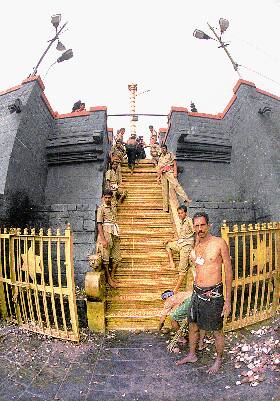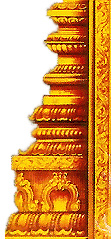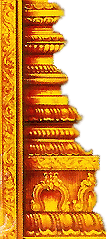Devotees committed to Sabarimala pilgrimage should wear the Mudra Mala of Rudraksha or Tulsi beads before a Mandalam covering 48 days beginning on Karthikai month-day one- (November-December) in the presence and blessings of a Guru either at his residence after a puja or in a temple. Supposing the devotee has no Guru, he has to wear it in a temple, after placing the mala at the feet of the Lord, perform archana through the priest offering him Dakshina, consider the Lord Himself as Guru and then wear the mala.
Things the devotee has to carry with him:
The devotee should carry some important worship materials with him in a bag, black or blue in colour which will have two compartments. It is spacially made so that it will give a good balance on both sides of the head. This bag is called Irumudi.He has to carry the following materials in one part.
1.Turmeric powder – minimum 100 gms to be offered to Bhagawathi, Manjamatha.
2.Sandal powder packet
3.Kum kum packet
4.Coconut filled with ghee
5.Pure cow ghee
6. 5 coconuts to be broken at Erimeli, Sabari Peetam, Saranguthi, and two while ascending and descending the 18 steps at the shrine
7.Small rose water bottle
8.Camphor packet
9.Raw rice
He may carry some cooking materials in the other part of the bag to be used on the way.
10 disciplines to be rigidly followed during the commitment period:
1.The most important is Brahmmacharya – celibacy - during the period.
2.He has to bathe in cool water only (Sabarimala pilgrimage occurs in winter) twice a day – morning and evening and worship Lord Aiyappa with a determined mind.
3.They should scrupulously avoid non-vegetarian food, liquor and tobacco and drugs.
4.They have to use dresses in black, blue, green or saffron colours only.
5.The Mala worn with the blessing of Guru should not be removed even during bathing.
6.In case of any sad incidents in the family as death of blood-bond relatives as father, mother, sisters and brothers, the mala should be removed with the consent of the Guru before joining the funeral rituals.
7.He cannot go to the hill that year.
8.They should not participate in functions for women or visit a house where a child is born.
9.They can accept food from women only after completion of 7 days of their menstrual period.
10.They should not dine in any house except in the house of a co-pilgrim so committed for Sabari pilgrimage. They can accept fruits and milk from others.
Things for other needs for the journey:
 Besides things in the Irumudi bag, the pilgrim will need certain things for general use on the way as a torch light, tooth paste and brush, Vibhuti, sandal and kumkum, extra clothes for change, a candle, match box, a plastic sheet for protection from rain, a small lamp for deepa, ghee and wick and a full blanket. These are necessary to keep the journey comfortable. Besides things in the Irumudi bag, the pilgrim will need certain things for general use on the way as a torch light, tooth paste and brush, Vibhuti, sandal and kumkum, extra clothes for change, a candle, match box, a plastic sheet for protection from rain, a small lamp for deepa, ghee and wick and a full blanket. These are necessary to keep the journey comfortable.
How the name Sastha came in:
People of southern districts in Tamilnadu pronounce Sastha as Saththa meaning a congregation. No one can go to Sabarimala alone, they have to go in groups. Being worshipped by a crowd, the deity came to known as Sastha. In those days the maximum number of devotees in a group was about 60 or 70. It was not in lakhs as today, not even in hundreds. They took with them some weapons as axe and sickles too to face wild forest animals. Of the group only about 10 or 15 will return safely while other die on the way or killed by animals. The surviors became Gurus.
Why ghee ?
The tradition of taking ghee to Lord Aiyappa started with his adopted father the king of Pandala. When Aiyappa expressed His wish to part with him to the jungle, the father, with tears in eyes asked Him how he could come to see him through the dark jungle and rocky hills. Lord told him that Garuda the eagle would guide him safely through the journey. During the hard journey, sitting at some spots completely exhausted the king cried Ayo, Appa an expression of weariness. This sound became the name Aiyappa, according to some traditional story. Garuda guidance has a great significance.
A father cannot go to see a beloved son with an empty hand. He has to take something to offer him. He chose ghee that does not go junk shortly. He took with him preparations made of ghee to preserve the freshness and taste till he reached his son after a long journey consuming many days. This is the philosophy behind the ghee coconut being taken in the Irumudi bag by the devotees.
First Aiyappa temple:
Vishvam in Sanskrit means World-Universe. It has six parts beginning from the sitting part of the human body to head at the top. So some parts of the world – in this context India, are attributed to these six parts viz. Mooladhara, Swathishtana, Manipooraga, Anagadha, Vishuddhi, Aagna, Sahasrara or Bhrammarandra. Every human body too has this aspect and those enlightened in the philosophy undertake some necessary spiritual exercises to take the power (Kundalini) to the head from the sitting part. Great and holy places and shrines represent these Chakras. This is an elaborate philosoly which only great scholars can handle and explain.
For Lord Aiyappa Mooladhara are His legs, Swathishtana the waist, Manipooraga the belly, Anagatham the private part, Vishuddhi the mind, Aagna the back neck and Brahmmarandra the head. For Shiva Kshetras, Mooladhara is Tiruvarur, Swathishtana is Tiruvanaikaval, Manipooraga is Tiruvannamalai, Anagatham is Chidambaram, Vishuddhi is Kalahasthi. Aagna is Varanasi-Kasi and Brahmmarandram is Kailash.
Similarly, for Lord Aiyappa, Mooladhara is the Sori Muthian temple in Papanasam, Swathishtana is Achankoil, Manipooragam is Ariyangavu, Anagatha is Kulathupuzha, Vishuddi is Pandalam, Aagna is Sabarimala and the Brahmmarandra is Kanthamalai. The first temple for Aiyappan is the Sorimuthian temple in Papanasam according to this theory.
Dharma Sastha graces here in the name of Sorimuthu Aiyanar. This was alo in the midst of dark jungles in the Pothigai hills housing wild animals. River Tambiraparani flows close by. On the Aadi new moon day in July-August, huge number of devotes gather here to perform Tarpan to their ancestors and worship Lord Aiyappa for relief from sins. Its present development as a tourist centre has enhanced the importance of Papanasam.
Sri Sastha Pancharatna Sloka:
The following verses should be chanted with the refrain “Swamiya Saranam Aiyappa” at the end of each verse and prostration submitted.
Loka veeram mahabhoojyam sarva rahakaram vibhum – Parvathi
Hrydayanamdam sastharam pramamyaham (Swamiya saranam Aiyappa)
Vipra Vipra bhoojyam vishwa, vandhyam Vishnu Shambo priyam sudham
Kshipra prasada niradham satharam pranamamyaham (Swamiye)
Matha madhanga gamanam Karunyam rudha bhooritham
Sarva vigna haram devam sastharam pranamamyaham (Swamiye)
Asmath Kuleswaram devam asmath shatru vinasanam
Asmath Ishta pradhadharam sastharam pranamamyaham (Swamiye)
Pandyesa Vamsa thilakam Keralee Keli vigraham
Arthadhrana parama devam sastharam pranamamyaham (Swamiye)
Triyambaka puradeesam Gaganadeepa saman vrdham
Gajadu maham vandhe sastharam pranamamyaham (Swamiye)
Shiva veerya samudh bhoodham Srinivasa dhanurdhbavam
Shikia Haanoojam vandhe sastharam pranamamyaham(Swamiye)
Mantra for wearing the Mala:
Gnanamudram Sasthru mudram Guru mudram namam yaham
Vanamudram Shuktha mudram Rudra mudram namam yaham
Shadamudram Sathya mudram Vrudhu mudram padhu sadhabime
Shabaryasrama sathyena mudram Padu sathabime
Guru Dhakshinya poorvam thasya nugraha karine
Sharanagadha mudrakyam dhvan mudram dharaya yaham
Chinmudra Kesari Mudram badra mudram namam yaham
Shabaryachala Mudrayai Namasthubyam Namo Nama.
Mantra for removing the mala:
Apoorva Chalaroha – divya dharsana karine
Shastru mudrath Mahadeva – Vehame viradha vimochanam.
Deities of 18 steps:

01. Vinayaka
02. Shiva
03. Parvathi
04. Muruga
05. Brahmma
06. Vishnu
07. Ranganathan
08. Kali
09. Yama
10. Sun – Surya
11. Chandra – Moon
12. Sevvai – Mars
13. Budha – Mercury
14. Guru – Jupiter
15. Shukra – Venus
16. Sani – Saturn
17. Rahu – dragon’s head
18. Ketu – dragon’s tail
Happy news to Aiyappa devotees -
Tamil, Telugu, Kannada and Hindi
Songs to be played at Sabarimala
Travancore Devaswom Board, with a view to uphold the cosmopolitan nature of the Sabarimala Aiyappan Temple, has decided to play devotional songs of Lord Aiayppa in four more languages other than Malayalam and Sanskrit.
Usually the temple opens in the morning with the Sanskrit ‘Suprapatham’ ‘Vande Vigneswaram’ rendered by K.J. Jesudas and in the evening the Malayalam song ‘ Sree Kovil nada thurannu’ rendered Jayan of the Jaya-Vijayan duo. The temple closes with ‘Harivarasanam’ sung by Yesudas.
Henceforth, Tamil, Telugu, Kannada and Hindi songs will be played along with the Malayalam and Sanskrit songs while opening the temple in the morning and evening, but Harivarasanam’ alone will be played at night as usual.
Two new albums consisting of devotionals sung by singers such as Seekazhi Govindarajan, S.P. Balasubramaniam, Narayana Reddy, Veeramani-Kannan and others have been prepared for the purpose.
The songs such as ‘Sabarimalayil thanga Sooryodhayam’, Aadi Varukirathu Aiyappanin’, Chandanam Manakkuthe’, Baghawan saranam Bhaghavathy saranam’, Giri Uthungame’ Thulasi mala aninju’, ‘Udichiyarannu mamala mele’ … have ben included in the new album
The album to be played in the morning has been named as ‘Manikanda Suprapatham’ and the one to be played in the evening, ‘Sandhya Deepam.’
The idea of playing songs in different languages was mooted by Sabarimala Special Commissioner S.H. Panchapakesan and it was approved by the board. The decision was made considering the heavy flow of pilgrims from different parts of the country.
The new CD was released by Kerala Devaswom Board Minister V.S. Sivakumar at the Dharmasastha Auditorium at Sabarimala on June 15, when the temple opened for the monthly pujas. Board President M. Rajagopalan presided.
Additional Chief Secretary K. Jayakumar delivered the keynote address.
|





